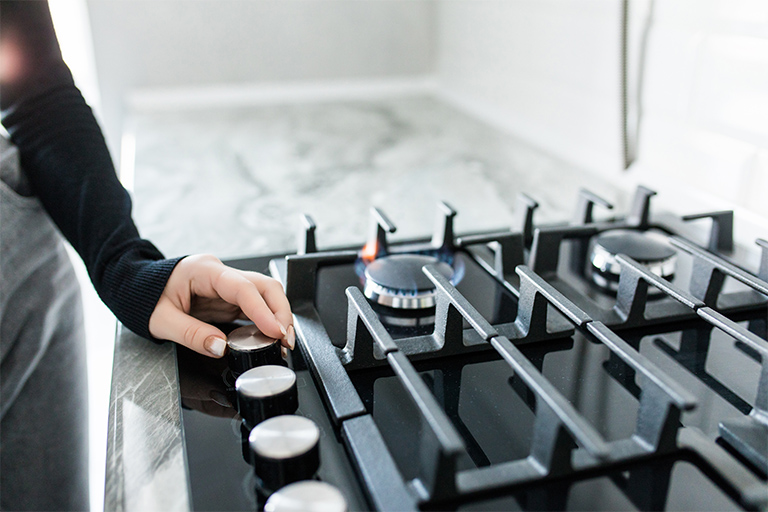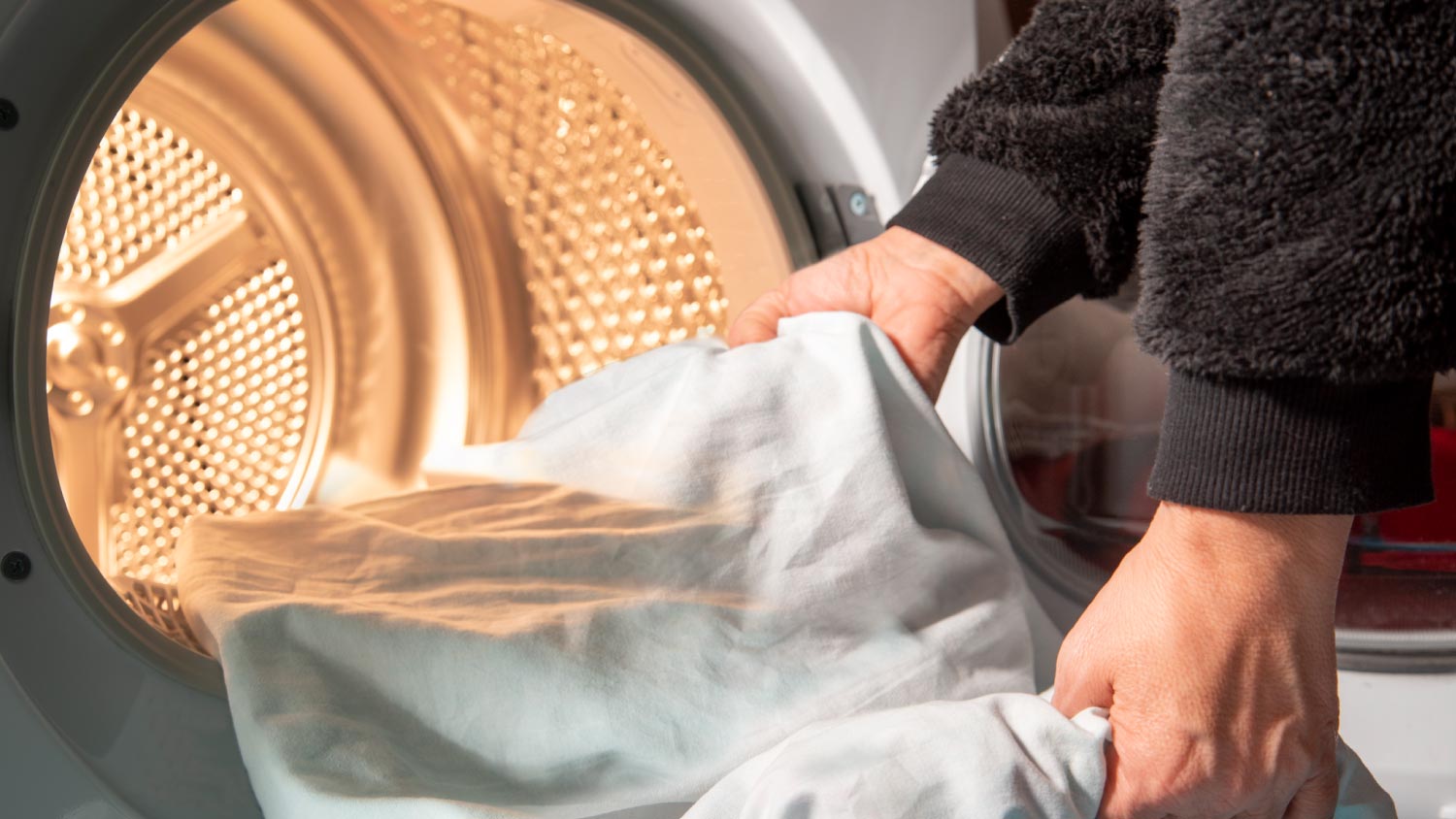
Discover the cost to install a gas cooktop. Learn about average prices, key cost factors, and tips to save on your gas cooktop installation project.
A clean dryer means no fire


Dryer fires can happen due to lint buildup, clogged ducts and vents, electrical malfunctions, and improper use.
Preventing dryer fires can be as easy as having your dryer professionally installed, cleaning the lint trap after each use, and being alert for a burning smell.
A dryer repair pro can inspect the dryer periodically to ensure it’s working properly.
Call 911 immediately if a dryer fire breaks out in your home.
A dryer is meant to dry your clothes, but because of the amount of heat a dryer generates, it can end up causing a dryer fire. According to the National Fire Protection Association (NFPA), firefighters respond to over 13,000 home fires caused by dryers yearly. Let’s take a look at seven common causes of dryer fires and what you can do to prevent them and protect your home—while still getting fluffy laundry.
The NFPA report found that 27% of dryer fires resulted from dust, fiber, or lint igniting. Lint can build up in the lint trap if it isn’t emptied regularly and lead to fires if it ignites from the heat in the dryer.
Make sure to clean the lint trap out every time you empty the dryer. Doing so will prevent lint buildup, which can be the source of a dryer fire.
The ductwork that runs from the dryer to the exterior vent can get clogged with lint and even small articles of clothing. Or, small animals and rodents may make their home in the warm, sheltered environment of the duct. If you notice that clothes are taking longer to dry or don’t feel any hot air escaping from the exterior vent, a clogged duct or vent could be the problem.
Remove the ductwork and clean it out, but make sure to replace it correctly. You can also clean your dryer vent where it exits your home to ensure it’s clear. If you suspect that an animal has made the vent its home, you should call a wildlife removal specialist near you so they can take the proper precautions and clean the area.
Pushing the dryer too close to the wall could crush the exhaust vent and prevent air from moving through it. In some cases, the dryer duct may get bent or twisted. In these cases, lint can build up in the duct and ignite when hot air gets trapped.
Make sure you do a visual inspection of the ductwork periodically to ensure it’s not twisted, bent, or crushed. If it is, pull the dryer away from the wall and allow the duct to straighten. If it’s crushed beyond repair, you’ll need to replace it or call a local dryer repair pro near you.
Anything with mechanical components or electrical wiring comes with the risk of fire. So, if your dryer’s wiring is faulty or a mechanical component fails, it could catch on fire with little warning.
Have your dryer professionally installed to reduce the risk of wiring issues. You can also have a dryer repair pro do yearly maintenance to ensure everything works properly. If you notice that it smells hot or hear noises you shouldn’t, turn the dryer off and call a pro.

Avoid drying anything stained with flammable liquids, including oil, gas, or cleaning agents. These chemicals may not get cleaned thoroughly during the wash cycle and can ignite when exposed to the dryer's heat.
Hand-wash any items that have been soiled with flammable materials. You may need to wash them twice to get them clean. Then, hang dry to avoid any contact with heat.
Drying things that aren’t intended to be dried, such as plastic, rubber, or foam items—for example, a bath mat with a rubber backing—can overheat and cause a dryer fire.
This one’s really simple—don’t put items in the dryer that should be air-dried.
A dryer can overheat because of a lint buildup, faulty wiring, mechanical issues, a malfunctioning thermostat, or items that shouldn’t be dried.
If you think your dryer is overheating, turn it off immediately and try a few solutions on your own, such as cleaning the lint trap and checking for a clogged vent or duct. If you think you’ve fixed the issue, you can turn the dryer on again, but if it smells hot, turn it off and call a pro.
While you can do some troubleshooting on your own if you think your dryer isn’t working as efficiently as it should, remember that you’re dealing with an electrical system and heat, and the risk of fire is very real. Call a pro if you think your drying isn’t functioning properly and you can’t find an obvious cause. You can also have a pro come out and inspect the dryer yearly to ensure it’s clean and there aren’t any mechanical or electrical issues.
Some dryer fires result from faulty electrical wiring or mechanical failures, but there are ways to prevent dryer fires from occurring.
Clean the lint trap after every load
Check the exterior vent periodically and clear any lint or debris
Make sure the duct isn’t bent, twisted, or crushed
Be on alert for a clogged duct and call a pro to clean it
Only dry clothes, towels, or other items approved for use in the dryer
Have a dryer repair pro inspect the unit yearly
Keep a fire extinguisher or fire blanket near the laundry room for easy access if a fire does start
Phil understood the style I wanted and suggested options for materials (unlike the standard kitchen folks who kept pushing the same cabinets everyone buys). He stepped through all the decisions about the details with me, using his computer program to show the differences between the choices....
Very well repaired quickly!
The service and quality was great. Doug went above and beyond and made other small repairs needed while he was on the job. Very trustworthy and friendly!
They were on time. Did a thorough job everything was very clean. They did a the whole house INCLUDING APPLIANCES. Price was very reasonable.
I was called back immediately when I contacted this provider on Angie's list. Robert called ahead and arrived when he said he would. After looking over the appliance, explained what he thought the problems might be and worked on them. He fixed the problem at the bottom of the freezer that...
Rod was great. He repaired the dry wall in my utility closet so well you can't even tell there were holes there! I would highly recommend them.
It was pretty clear to me that the problem would turn out to be that the motor was burned out and would cost a few hundred dollars to replace. Ready for that, I called Affordable Appliance Service. He asked some questions about the machine, eliminated various possibilities, had me turn...
The service was very through and appeared to be very good. He did some things that repair people had never done before and patched leaks.
All work done in one day. Very pleased with workmanship; they advised us of other items that might need repairs soon; some of which we already were aware of, some not.
From average costs to expert advice, get all the answers you need to get your job done.

Discover the cost to install a gas cooktop. Learn about average prices, key cost factors, and tips to save on your gas cooktop installation project.

Installing a gas dryer can help you save on your monthly energy bills. Depending on whether you need a new gas line, gas dryer installation costs will vary greatly.

Discover the average cooktop installation cost, key price factors, and tips to save. Learn what impacts your total cost and how to budget for your new cooktop.

Learning how to remove an oven door makes it easier to clean or repair it. Follow these steps to remove your oven door without damaging it.

It may seem like there are a zillion types of wood stoves—but there are really two main categories (and other decisions to make from there). Learn more here.

If your microwave comes on when the door is opened, there are several potential causes to address. Find out the culprits with this guide.